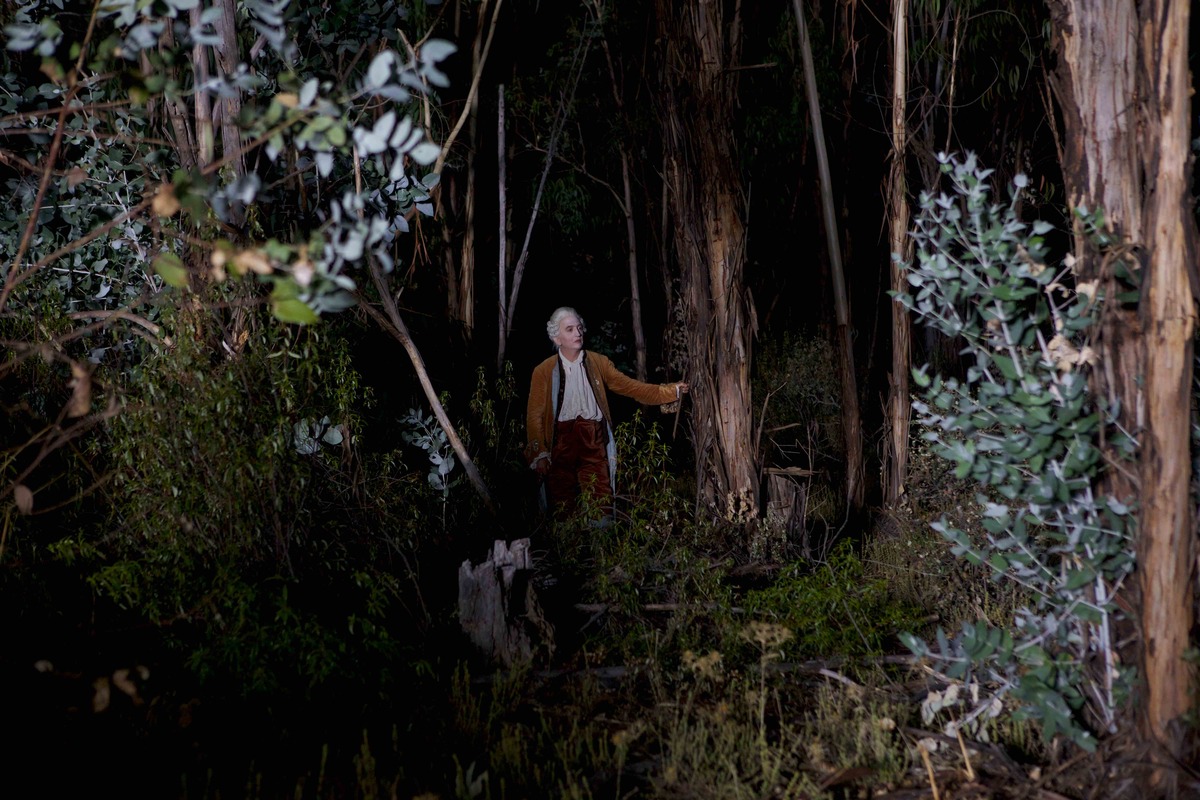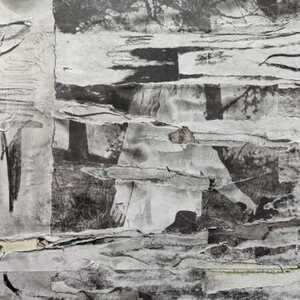
Liberté
directed by Albert Serra
This review of Albert Serra’s Liberté was inspired by and is dedicated to the experimental filmmaker, Luther Price, who died at the age of 58 last week, leaving behind some of the strongest images that I have experienced on screen. The very first piece of Price’s that I viewed—which was fortuitously screened at the film society run by his teacher, Saul Levine—was his 1989 short which was produced at the height of the early AIDS epidemic, Sodom. To create this work, Price assembled gay porn footage that he salavged out of dumpsters in Boston’s red light district, affectionately known then to locals as “The Combat Zone.” This borderline grotesque, non-couple friendly porn was mixed with the sounds of Gregorian chants and additional found footage from Biblical epics that were discovered by Price, which altogether left me emotionally staggered by an atmosphere that no constructed narrative film has ever been able to duplicate.
So, for that film and for much of his subsequent work that I was lucky enough to have had the opportunity to see, I will always be forever grateful to Price for expanding my expectations for what can be achieved in film by incorporating a radical and distinct production ethos. Price’s work throughout his career, like many experimental filmmakers, was so reliant on process. In his particular idiom, that process was not in filming, but in the selection of found footage, the manipulation of what he found, and the way that the film would be shown, be it the chemicals added to the print or the burying of film reels in his own backyard to produce rot and mold. What I gained from Price was not this fleeting feeling of solely witnessing the notorious or audacious within his work, but a hunger as a viewer to understand the minutia contained within the creative process of a filmmaker prior to, or even shortly after, seeing the final product to fully appreciate the work. Over the years, in uncovering the creative mysteries behind a film, whatever magic in the unknown that I’ve lost along the way has usually been replaced with a keener understanding of how the elements selected aimed to advance the director’s intent, leaving me to judge the final piece’s success based on not only my immediate reactions to the work, but also on whether those reactions aligned with the director’s desires.
As for Albert Serra’s Liberté, my viewing came on the heels of my appreciation for what the director accomplished with his feature, The Death of Louis the XIV, a claustrophobic observation of the final days of the bedridden monarch who was adeptly portrayed by French New Wave icon, Jean-Pierre Léaud. Serra’s camera hovers over Louis’ bed as his family wanders in and out of the room, politicians debate, and doctors unemotionally probe Louis while his body rots from gangrene and his reign slowly dissipates along with his mortal coil. Serra’s ability to keep an emotional distance throughout these morbid proceedings, even during uncomfortable moments of physical intimacy, breaks with much of what we have come to expect from a historical period piece. My admiration of The Death of Louis the XIV was distinctly aided by understanding Serra’s unique process in its creation, so I feel that in order to properly review Liberté, which uses a bold experimental production ethos to generate its narrative through performance, I must give a basic plot setup, and then explore what I gleaned from reading and listening to multiple interviews with Serra about his production philosophies in the making of Liberté, as it is a feature that demands to be reviewed on both a procedural and outcome level.
Set entirely in a small patch of forest, Liberté begins in the short moments before sunset. As the sun falls from the sky, a group of libertines engage in discussions that set the historical context of their period, one in which the emerging French Revolution’s impact has become a concern for the libertines, who must now seek other European nations for shelter as they have lost their prerogatives of status and protection which were once bestowed upon them by the now ravaged monarchy. This pastoral setting away from the mob violence engulfing Paris is converted into a hedonistic court in which the libertines can exercise their now infamous agendas as they see fit. When the sun has completely set, and the group is covered under the security of darkness, they begin their nefarious practices of sexual and violent acts upon one another, and Serra moves our focus from one flesh abused cluster to another within and outside of the libertine’s appointed carriages and gives us only graphic conversations and verbal descriptions of depravity to break up the unrelenting visual debauchery.
Liberté, the film, is the third incarnation of this libertine material. Serra originally produced Liberté as a stage play in Germany, and subsequently developed it into an installation piece involving two separate screens that couldn’t simultaneously be seen by the audience. He then adapted this installation into its feature film version, which based on the description above, you may believe is yet another film inspired by the writings of Diderot and de Sade. But the particular way in which Serra decided to create Liberté distinctly sets it apart from its predecessors—it embraces the libertine ethos in not only what the scenes present, but also in how the scenes were captured, all while paradoxically providing evidence that any verbatim visual retelling of libertine practices on film will be less distressing and less impactful than our own imagination’s ruminations on such practices of supreme hedonism.
Liberté had little that could be called a script: no dialog was composed by Serra, and he only created the atmosphere for the shoot. Professional and non-professional actors were used (including some of the film’s technicians who were drafted into graphic scenes without much notice), and Serra did not offer any specific direction for what the actors should do during filming. As he commented to film critic Dennis Lim in a recent interview: “The cast was naked in all senses. Everyone is naked in front of the camera. They have no help, no external help.” Serra utilized his lack of communication to encourage more action amongst his actors, as he relied on the conflict between professional actors’ natural inclination to craft a character, their expectations of direction from him, and his silence and non-intervention to ultimately force them into more natural, rather than expository or dramatic, actions.
Furthermore, Serra instructed his camera operators to only use zoom lenses and to remain distant from the performances. The exclusive use of the zoom was specifically designed so that the actors would never truly know where the focus was at any particular time, preventing their trained impulses from altering their positioning and body language to adjust to the shot. Separately, the distance of the film crew even further lessened the actors’ physical connection to the director, whom they might have seeked for protection or guidance if they felt a scene was failing. Lastly, Serra insisted that shooting occur in hours-long stretches to reinforce the actors’ feeling of indifference towards the camera. Amazingly, this amount of improvisational freedom, combined with physical distancing, resulted in the portrayal of sexual acts that never transpire in a shocking fashion by today’s standards. Nor are these moments sexually gratifying for the participants, which amplifies the feeling of waste that is at the core of the libertine doctrine.
The aforementioned filming process by Serra resulted in over 300 unique hours of footage which was then given to three editors to assemble. Each editor was instructed to only utilize the footage that Serra deemed to have merit, and those pieces were then combined in a way such that no traditional narrative tension could be formed. As a result of these narrative elimination efforts, the editing structure creates its own form of tension for the viewer, who continuously searches for meaning within and between the scenes and may not find anything satisfactory in all of the excess.
Though differing in their genres, their source images, and their addressed codes of morality, both Luther Price’s Sodom and Albert Serra’s Liberté use extreme images cultivated from reality to underscore our apathy towards human suffering. In the case of Sodom, the visceral images of tissue damage during the sex act mixed with the austere sounds and visuals related to Christianity embody the public’s craven demonization of gay sex during the AIDS epidemic that led to the hypocritical apathy towards the vulnerable, high-risk group that increased and prolonged their suffering overall. And in Liberté, Serra’s transformation of the libertine’s lurid concepts into perfunctory and mundane images forces us to confront our own apathy towards the suffering and extremes we regularly see and dismiss in our current media saturated world. Through their processes and their films, Price and Serra remind us that it is not the image that should disturb us—it is the absence of our reaction to it and the lack of our desire to understand its subject and context that should keep us up at night and inspire us to change.
◼
Liberté is available now through a select number of local, independent theaters’ virtual screening rooms, with half of the ticket proceedings going directly to the available theater of your choice.












